Srijan Biology Class 10 Pdf Download
Practice Test - MCQs test series for Term 1 Exams
SELINA Solutions for Class 10 Biology Chapter 4 - Absorption by Roots : The Processes Involved
Chapter 4 - Absorption by Roots : The Processes Involved Exercise Ex. 1
Question A.1
Absorption of water by the plant cells by surface attraction is called:
a) Diffusion
b) Osmosis
c) Imbibition
d) Endosmosis
Solution A.1
c) Imbibition
Question A.2
A plant cell placed in a certain solution got plasmolysed. What was the kind of solution?
a) Isotonic sugar solution
b) Hypotonic salt solution
c) Hypertonic salt solution
d) Isotonic salt solution
Solution A.2
c) Hypertonic salt solution
Question A.3
The state of a cell in which the cell wall is rigid and stretched by the increase in volume due to the absorption of water is called
a) Flaccidity
b) Turgidity
c) Capillarity
d) Tonicity
Solution A.3
b) Turgidity
Question A.4
Which one of the following is a characteristic NOT related with the suitability of the roots for absorbing water?
a) Tremendous surface area
b) Contain cell sap at higher concentration than the surrounding water
c) Root hairs have thin cell walls
d) Grow downward into the soil
Solution A.4
d) Grow downward into the soil
Question A.5
Movement of molecules of a substance from the region of their higher concentration to the region of their lower concentration without the involvement of a separating membrane, is called:
a) Osmosis
b) Diffusion
c) Active transport
d) Capillarity
Solution A.5
b) Diffusion
Question A.6
Osmosis and diffusion are the same except that in osmosis there is
a) a freely permeable membrane
b) a cell wall in between
c) a selectively permeable membrane in between
d) an endless inflow of water into a cell
Solution A.6
c) a selectively permeable membrane in between
Question A.7
The highest water potential (capacity to move out to higher concentrated solution) is that of
a) Pure water
b) 10% salt solution
c) Honey
d) 50% sugar solution
Solution A.7
a) Pure water
Question A.8
The space between the cell wall and plasma membrane in a plasmolysed cell is filled with
a) isotonic solution
b) hypotonic solution
c) hypertonic solution
d) water
Solution A.8
d) water
Question A.9
What is responsible for guttation?
a) Osmotic pressure
b) Root pressure
c) Suction pressure
d) Capillarity
Solution A.9
b) Root pressure
Question A.10
The most appropriate characteristic of semi-permeable membrane is that
a) it has minute pores
b) it has no pores
c) it allows the solute to pass through but not the solvent
d) it allows a solvent to pass through freely but prevents the passage of the solute
Solution A.10
d) it allows a solvent to pass through freely but prevents the passage of the solute
Question B.1
Name the following:
(a) The condition of a cell placed in a hypotonic solution.
(b) Process by which intact plants lose water in the form of droplets from leaf margins.
(c) Process by which water enters root hairs.
(d) The tissue concerned with upward conduction of water in plants.
(e) The term for the inward movement of solvent molecules through the plasma membrane of a cell.
(f) The process by which molecules distribute themselves evenly within the space they occupy.
(g) The pressure which is responsible for the movement of water molecules across the cortical cells of the root.
Solution B.1
(a) Turgidity
(b) Guttation
(c) Osmosis
(d) Xylem
(e) Endosmosis
(f) Diffusion
(g) Root pressure
Question B.2
Give the equivalent terms for the following:
(a) Pressure exerted by the cell contents on the cell wall.
(b) The condition in which the cell contents are shrunken.
(c) Loss of water through a cut stem.
Solution B.2
(a) Turgor pressure
(b) Flaccidity
(c) Bleeding
Question B.3
Complete the following statements:
(a) Hypotonic solution is one in which the solution kept outside the cell has lower solute concentration than __________ the cell.
(b) Active transport is one in which the ions outside the roots move in with expenditure of energy __________.
(c) The bending movements of certain flowers towards the sun and the sleep movements of certain plants at night are examples of _____.
Solution B.3
(a) the fluids inside
(b) from the region of their lower concentration outside to the region of their higher concentration inside
(c) turgor movements
Question B.4
Fill in the blanks by choosing the correct alternative from those given in brackets:
(a) When placed in a more concentrated solution, the cell contents will ........... (shrink/swell up)
(b) The pressure by which the ............. molecules tend to cross the semi-permeable membrane is called osmotic pressure. (salt/water)
(c) Active transport is in a direction .............. to that of diffusion. (opposite/same)
Solution B.4
(a) shrink
(b) water
(c) opposite
Question B.5
Match the terms in column I those in column II
| Column I | Column II | |
| a | Xylem | (i) semi-permeable |
| b | Phloem | (ii) permeable |
| c | Cell membrane | (iii) downward flow of sap |
| d | Root pressure | (iv) upward flow of water |
| e | Cell wall | (v) guttation |
Solution B.5
| Column I | Column II | |
| a | Xylem | (iv) upward flow of water |
| b | Phloem | (iii) downward flow of sap |
| c | Cell membrane | (i) semi-permeable |
| d | Root pressure | (v) guttation |
| e | Cell wall | (ii) permeable |
Question C.1
Differentiate between the following :
(a) Plasmolysis and deplasmolysis
(b) Turgor pressure and wall pressure
(c) Guttation and bleeding
(d) Turgidity and flaccidity
Solution C.1
(a)
| Plasmolysis | Deplasmolysis |
| 1. It refers to the shrinkage of the cytoplasm and withdrawal of the plasma membrane from the cell wall caused due to the withdrawal of water when placed in a hypertonic solution. 2. In Plasmolysis, the cell becomes flaccid. | 1.Deplasmolysis is the recovery of a plasmolysed cell when it is placed in water, wherein the cell's protoplasm again swells up due to the re-entry of water. 2. In deplasmolysis, the cell becomes turgid. |
(b)
| Turgor pressure | Wall pressure |
| Turgor pressure is the pressure of the cell contents on the cell wall. | Wall pressure is the pressure exerted by the cell wall on the cell content. |
(c)
| Guttation | Bleeding |
| Guttation is the process by which drops of water appear along leaf margins due to excessive root pressure. | Bleeding is the loss of cell sap through a cut stem. |
(d)
| Turgidity | Flaccidity |
| 1. It is the state of a cell in which the cell cannot accommodate any more water and it is fully distended. | 1. It is the condition in which the cell content is shrunken and the cell is not tight. |
Question C.2
Mention whether the following statements are true (T) or false (F). Correct the false statements by altering the last word only.
(a) Addition of salt to pickles prevents the growth of bacteria because they turn turgid.
(b) Cells that have lost their water content are said to be deplasmolysed.
(c) Xylem is the water conducting tissue in plants.
(d) The protoplasm shrinks, when a cell is kept in hypotonic solution.
(e) The cell wall of the root cell is a differentially permeable membrane.
Solution C.2
(a) False. Addition of salt to pickles prevents the growth of bacteria because they turn flaccid.
(b) False. Cells that have lost their water content are said to be plasmolysed.
(c) True.
(d) False. The protoplasm shrinks, when a cell is kept in hypertonic solution.
(e) False. The cell wall of the root cell is a permeable membrane.
Question C.3
Mention whether the following statements are true (T) or false (F) and give explanation in support of your answer.
(a) Guttation is another name for bleeding in plants.
(b) Soaked seeds burst their seed coats.
(c) If the phloem of a twig is removed keeping the xylem intact, the leaves of a twig wilt.
(d) Guttation in plants occurs maximum at mid-day.
(e) Raisins when submerged in water swell up due to endosmosis.
Solution C.3
(a) False. Guttation is the process by which drops of water appear along leaf margins due to excessive root pressure whereas bleeding is the loss of cell sap through a cut stem.
(b) False. There is only one seed coat in a seed.
(c) False. The leaves of the twig remain turgid since its xylem is intact and xylem is responsible for water conduction in plants.
(d) False. Guttation occurs due to excessive root pressure. It is maximum when root pressure is maximum which occurs in the early mornings or at night. This is because during these times, transpiration is very low and water absorption is very high.
(e) True.
Question D.1
Give two examples of turgor movements in plants.
Solution D.1
Examples of turgor movements in plants:
(i) In Mimosa pudica, a sensitive plant, the stimulus of touch leads to loss of turgor at the base of the leaflets and at the base of the petioles called pulvinus. This causes the folding and drooping of leaves of the plant.
(ii) The leaves of insectivorous plants close up to entrap a living prey. When the insect come in contact with the leaf, it loses it turgor hence closing the leaves of the plant.
(iii) The bending movements of certain flowers towards the sun.
(Any two)
Question D.2
Define the following terms:
(a) Imbibition
(b) Diffusion
(c) Osmosis
(d) Osmotic pressure
(e) Active transport
(f) Tonicity
(g) Root pressure
Solution D.2
(a) Imbibition: Imbibition is a phenomenon by which the living or dead plant cells absorb water by surface attraction.
(b) Diffusion: Diffusion is the free movement of molecules of a substance from the region of their higher concentration to the region of their lower concentration when the two are in direct contact.
(c) Osmosis: Osmosis is the movement of water molecules from their region of higher concentration to their region of lower concentration through a semi-permeable membrane.
(d) Osmotic pressure: Osmotic pressure is the minimum pressure that must be exerted to prevent the passage of the pure solvent into the solution when the two are separated by a semi-permeable membrane.
(e) Active transport: Active transport is the passage of a substance from its lower to higher concentration through a living cell membrane using energy from the cell.
(f) Tonicity: Relative concentration of the solutions that determine the direction and extent of diffusion is called tonicity.
(g) Root pressure: The upward flow of water due to heavy pressure from the roots is called root pressure.
Question D.3
Give reasons for the following:
(a) If you sprinkle some common salt on grass growing on a lawn, it is killed at that spot.
(b) If you uproot a plant from the soil, its leaves soon wilt.
(c) It is better to transplant seedlings in a flower-bed in the evening and not in the morning.
(d) A plant cell when kept in a hypertonic salt solution for about 30 minutes turns flaccid.
(e) Potato cubes when placed in water become firm and increase in size.
Solution D.3
(a) Common salt when sprinkled on the grass causes the Plasmolysis of grass cell ultimately leading them to death. Hence, if we sprinkle some common salt on grass growing on a lawn, it is killed at the spot.
(b) If a plant is uprooted, the leaves continue losing water by transpiration, but there is no more water absorbed the roots. This does not allow the compensation for the loss of water by transpiration; hence the leaves of the uprooted plant wilt soon.
(c) Transplantation causes stress to the seedlings. If the seedlings are transplanted in the morning, they would have to immediately bear the additional stress of excessive transpiration occurring during the hot afternoon. Transplantation in the evening helps the seedlings to adjust for a longer time during the night (cooler temperatures) because the quantity of water absorbed exceeds the loss of water through transpiration. Therefore, it is better to transplant seedling in a flower bed in the evening and not in the morning.
(d) In a hypertonic solution, the solution outside the cell has higher solute concentration than the fluids inside the cell. Therefore, water flows out from the plant cell due to exosmosis. The cytoplasm shrinks and the plasma membrane withdraws away from the cell wall and this the cell becomes flaccid. Hence a plant cell when kept in a hypertonic salt solution for about 30 minutes turns flaccid.
(e) Potato cubes contain excess of salts and sugars as compared to the water in which the cubes are placed. Hence, due to endosmosis, water from the surrounding enters the potato cubes making them firm and increasing their size.
Question D.4
Explain the mechanism of the closing and opening of the stomata.
Solution D.4
The closing and opening of the stomata depends on the turgidity of the guard cells. Each guard cell has a thicker wall on the side facing the stoma and a thin wall on the opposite side. Guard cells contain chloroplasts. As a result of the synthesis of glucose during photosynthesis and some other chemical changes, the osmotic pressure of the contents of the guard cells increases and they absorb more water from the neighbouring cells, thus becoming turgid. Due to turgor, the guard cells become more arched outwards and the aperture between them widens, thereby opening the stoma.
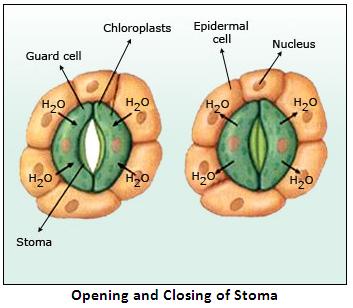
At night or when there is shortage of water in the leaf, the guard cells turn flaccid and their inner rigid walls become straight, thus closing the stomatal aperture.
Question D.5
What is transpirational pull? How is it caused?
Solution D.5
As water is lost from the leaf surface by transpiration, more water molecules are pulled up due to the tendency of water molecules to remain joined i.e. cohesion. This produces a continuous column of water throughout the stem which is known as 'transpiration pull'. A negative pressure or tension is produced in the xylem that pulls the water from the roots and soil. Transpirational pull is an important force which causes the ascent of sap.
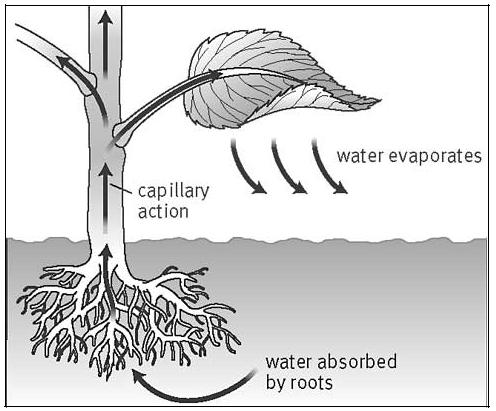
Question E.1
A leaf cell of a water plant was placed in a liquid other than pond water. After sometime, it assumed a shape as shown below:
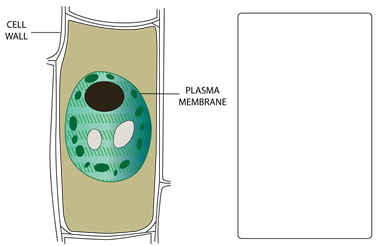
(a) Give the term for the state of the cell it has acquired.
(b) Name the structure which acts as a selectively permeable membrane.
(c) Comment on the nature (tonicity) of the liquid surrounding the cell.
(d) Name any one feature of this plant cell which is not present in an animal cell.
(e) Redraw in the space provided, the diagram of the cell if it is soon placed in ordinary water for some time.
Solution E.1
(a) Flaccid cell
(b) Plasma membrane
(c) The liquid is hypertonic solution. It has higher solute concentration outside the cell than the fluids inside the cell.
(d) Cell wall
(e) The cell will become turgid as follows:
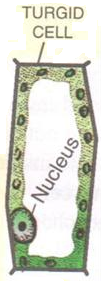
Question E.2
The diagram given below represents an experimental set-up to demonstrate a certain process. Study the same and answer the questions that follow:
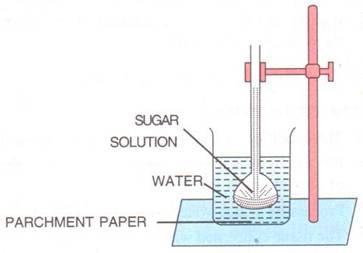
(a) Name the process.
(b) Define the above named process.
(c) What would you observe in the experimental set-up after an hour or so?
(d) What control experiment can be set up for comparison?
(e) Keeping in mind the root-hair, cell and its surroundings, name the parts that correspond to
(1) concentrated sugar solution
(2) parchment paper and
(3) water in the beaker.
(f) Name any other substance that can be used instead of parchment paper in the above experiment.
(g) Mention any two advantages of the process to the plants.
Solution E.2
(a) Osmosis
(b) Osmosis is the diffusion of water molecules across a semi-permeable membrane from a more dilute solution (with a lower solute concentration) to a less dilute solution (with a higher solute concentration).
(c) After an hour or so, the level of sugar solution in the thistle funnel will rise and the level of water in the beaker will drop slightly.
(d) For control experiment, the beaker will contain the water. At the same time, instead of the sugar solution; the thistle funnel with the cellophane paper tied on its mouth and inverted in the beaker will also contain water.
(e)
(1) Concentrated sugar solution → Cell sap (of higher concentration than that of the surrounding water) within the root hair.
(2) Parchment paper → Cell membrane of root hair.
(3) Water in the beaker → Water in soil.
(f) cellophane paper, egg membrane, animal bladder (any one)
(g)
(i) The roots of plants absorb water and minerals from surrounding soil due to osmosis.
(ii) Osmosis allows plants to absorb water from the soil which helps plants to keep cells alive in roots, stems and leaves.
(iii) Osmosis is also important in the opening and closing of stomata which is an important feature for the processes like transpiration and photosynthesis. (Any two)
Question E.3
The diagram below represents a layer of epidermal cells showing a fully grown root hair. Study the diagram and answer the questions that follow:

a. Name the parts labelled A, B, C and D.
b. The root hair cell is in a turgid state. Name and explain the process that caused this state.
c. Mention one distinct difference between the parts labelled A and B.
d. Draw a diagram of the above root hair cell as it would appear when a concentrated solution of fertilizers is added near it.
Solution E.3
a.
A - Cell wall
B - Cell membrane
C - Cytoplasm
D - Nucleus
b. A root hair gets turgid because of the absorption of water from the surrounding. Absorption of water by root hair is achieved by the process of osmosis. The concentration of water in the surrounding is more than that of the interior of the cell; this causes the water from the surrounding to move in because of endosmosis.
c.
| Cell wall | Cell membrane |
| The cell wall of a root hair is freely permeable and allows both salt and water to pass through. | The cell membrane of a root hair is semi-permeable and does not allow large dissolved salt molecules to pass through. |
d.
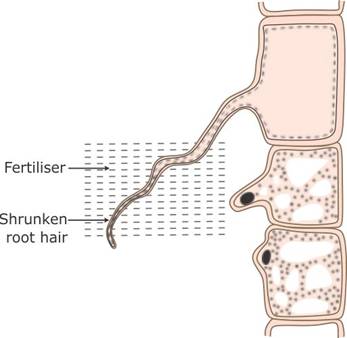
Question E.4
Study the diagram given below and answer the questions that follow:
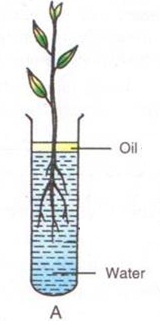
(a) Name the process being studied in the above experiment.
(b) Explain the process mentioned in (a) above
(c) Why is oil placed over water?
(d) What do we observe with regard to the level of water when this set up is placed in (1) bright sunlight (2) humid conditions (3) windy day?
(e) Mention any three adaptations found in plants to foster the process mentioned in (a) above
Solution E.4
(a) The process of water absorption by plant roots through osmosis is being studied here.
(b) A root-hair contains cell sap which contains higher concentration of salts as compared to outside soil water. This difference sets off osmosis and outside water diffuses into the root-hair. From the cell bearing root-hair, water passes into adjoining cells one after another to finally the xylem vessels.
(c) The surface of water was covered with oil to prevent any loss of water by evaporation.
(d) Roots absorb water and hence, the level of water in set up A falls down. Since the surface of water was covered with oil, there will be no effect of factors such as bright sunlight, humid conditions and windy day on the given set up. Hence, the level of water
(e) Adaptations in plants to foster the process of absorption of water by plant roots:
- Large surface area provided by rootlets and root hairs
- Root hairs containing cell sap at a higher concentration than that of the surrounding water
- Root hairs with thin walls
Question E.5
Three cylinders of potato were carefully dried on a blotting paper and weighed. Each piece weighed 3 grams. Each one was placed in the beaker as shown below:
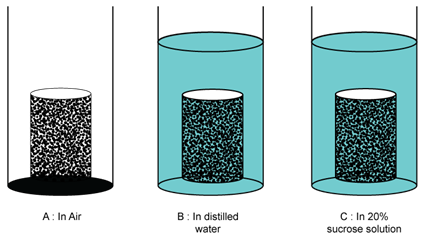
Answer the following questions:
(a) After 48 hours, which potato cylinder would be the heaviest?
(b) The movement of which substance is mainly responsible for the weight change in the potato cylinders?
(c) Name and define the process which is responsible for the movement of substance mentioned in answer (b).
(d) Write specific names of the processes which occur in beakers B and C [kinds of processes defined in answer (c)].
(e) Would there be any difference in the weight of the potato cylinder in beaker A after 48 hours? Give reason.
Solution E.5
(a) Cylinder B: In distilled water.
(b) When the potato cube is placed in water, the water starts entering the potato cube thus causing an increase in its size and due to pressure of cell contents on the cell wall, there appears a firmness in the wall of the cube.
(c) The physical process which is responsible for the movement of substance mentioned in answer (b) is osmosis. Osmosis is the movement of water molecules from their region of higher concentration to their region of lower concentration through a semi-permeable membrane.
(d) The process that takes place in beaker B is osmosis, which is diffusion of water across the membrane of the potato slice cells. Plasmolysis occurs in beaker C as the potato shrinks due to hypotonic solution of 20% sucrose solution.
(e) The weight of the potato cylinder in beaker A will be less as compared to initial phase after 48 hours due to loss of water to the surroundings through plasmolysis.
Question E.6
The figure given below is a diagrammatic representation of a part of the cross-section of the root in the root hair zone. Study the same and then answer the questions that follow:
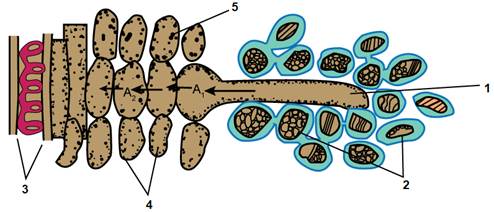
(a) Name the parts indicated by guidelines 1 to 5.
(b) Is the root hair cell unicellular or multicellular?
(c) Explain what would happen to the root hair cell if some fertilizer is added to the soil close to it.
(d) Name the process responsible for the entry of water molecules from the soil into A1 and then into A2.
(e) What pressure is responsible for the movement of water in the direction indicated by arrows?
(f) How is this pressure set up?
Solution E.6
(a) 1: Root hair cell, 2: Soil particles, 3: Xylem vessel, 4: Cortex cells, 5: Vacuole
(b) Root hair cell is unicellular.
(c) When fertilizers are added to the moist soil close to the root hair cell, it will form a hypertonic solution, resulting the protoplasm to shrink. The plasma membrane withdraws itself from the cell wall. Hence, the root hair also becomes limp or flaccid.
(d) Osmosis.
(e) Osmotic pressure.
(f) Osmotic pressure is set up due to difference in osmotic gradient.
Question E.7
Study the experimental setup in the figure and then answer the questions that follow.
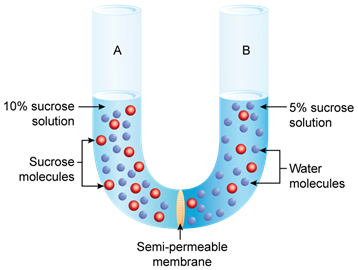
(a) What phenomenon is being studied by this setup?
(b) Explain the phenomenon mention in (a) above.
(c) What is meant by 'semipermeable membrane'?
(d) What will you observe in the setup after about half an hour? Give reasons for your answer.
Solution E.7
(a) Osmosis
(b) Osmosis is the movement of water molecules from their region of higher concentration (dilute solution) to their region of lower concentration (concentrated solution) through a semipermeable membrane.
(c) A semipermeable membrane is a membrane which allows the passage of molecules selectively. It allows a solvent such as water molecules to pass through it freely but prevents the passage of the solute (sugar or salt molecules in solution).
(d) Water molecules will continue to pass from 5% sucrose solution to 10% sucrose solution through the semipermeable membrane due to osmosis. This will continue till the concentration of water molecules becomes the same in both ends of the setup.
Question E.8
A candidate in order to study the process of osmosis has taken 3 potato cubes and put them in 3 different beakers containing 3 different solutions. After 24 hours, in the first beaker the potato cube increased in size, in the second beaker the potato cube decreased in size and in the third beaker, there was no change in the size of the potato cube. The following diagram shows the result of the same experiment.
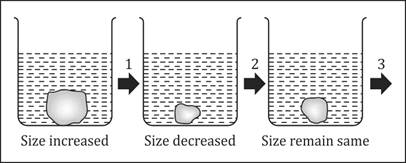
(a) Give the technical terms of the solutions used in the beakers 1, 2 and 3.
(b) In beaker 3, the size of the potato cube remains the same. Explain the reason in brief.
(c) Write the specific features of the cell sap of root hair which helps in absorption of water.
(d) What is osmosis?
(e) How does a cell wall and a cell membrane differ in their permeability?
Solution E.8
(a) Solution 1 - Hypotonic solution
Solution 2 - Hypertonic solution
Solution 3 - Isotonic solution
(b) In beaker 3, the solution present is an isotonic solution, i.e. the relative concentration of water molecules and solutes is the same in the solution as well as inside the cell. There is no movement of water molecules across the cell membrane. Hence, the size of potato cubes remains the same.
(c) The cell sap of root hair has a higher concentration of solute than the surrounding water.
(d) Osmosis is the diffusion of water molecules across a semi-permeable membrane from the region of dilute solution (i.e. a lower solute concentration) to the region of concentrated solution (i.e. a higher solute concentration).
(e) The cell wall is freely permeable to all substances, while the cell membrane is selectively permeable and allows only certain substances to enter or exit the cell.
Posted by: gigitarrase0198995.blogspot.com
Source: https://www.topperlearning.com/selina-solutions/icse-class-10-biology/selina-concise-biology-part-ii/absorption-by-roots-the-processes-involved
Post a Comment for "Srijan Biology Class 10 Pdf Download"